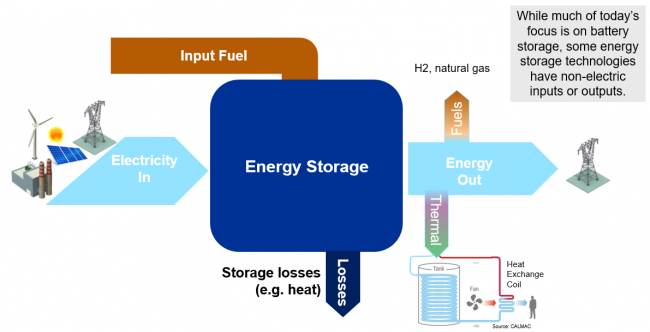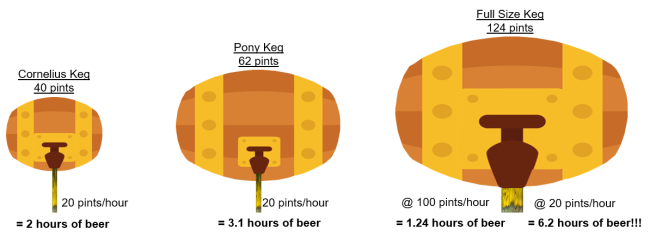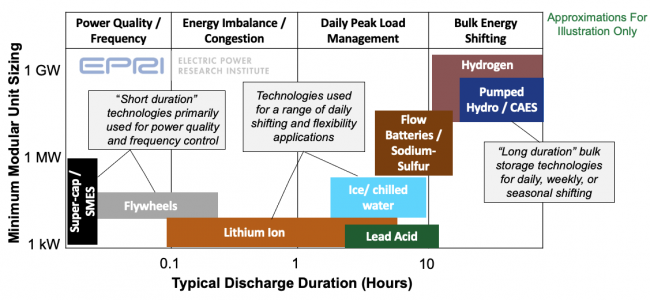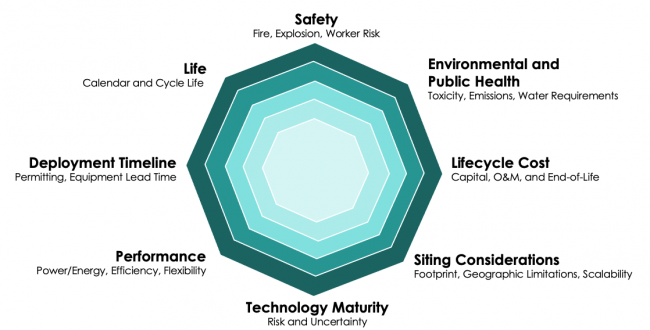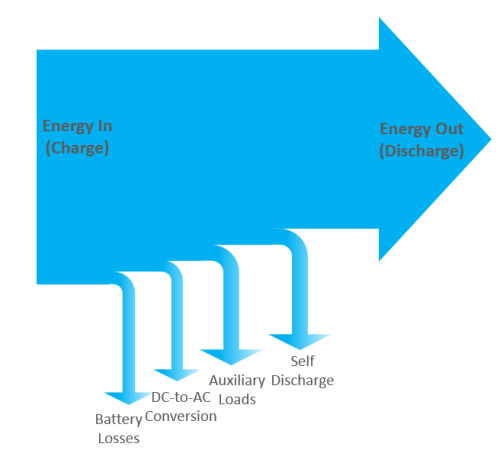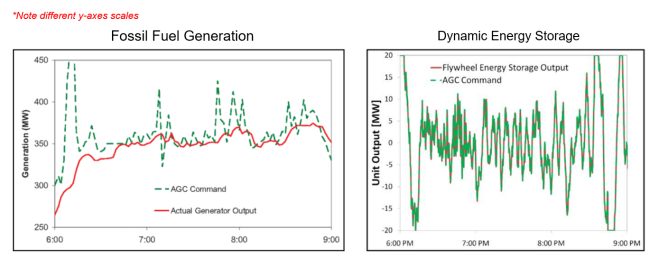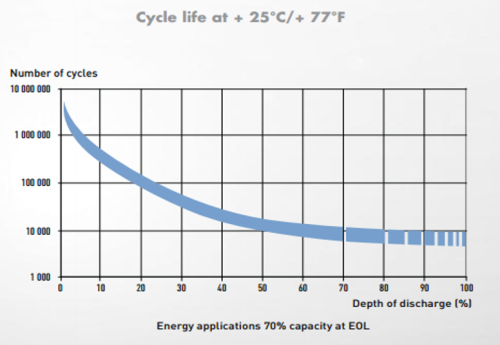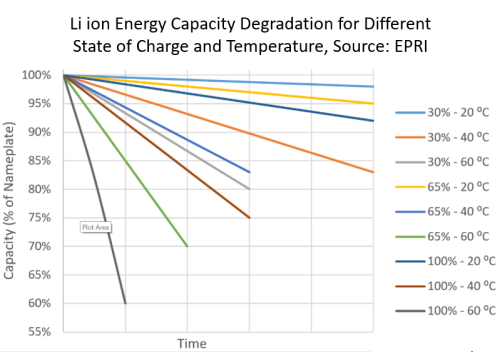Difference between revisions of "Energy Storage 101/Technologies"
| (34 intermediate revisions by one other user not shown) | |||
| Line 1: | Line 1: | ||
{{DISPLAYTITLE: Energy Storage {{SUBPAGENAME}}}} | {{DISPLAYTITLE: Energy Storage {{SUBPAGENAME}}}} | ||
| Line 7: | Line 5: | ||
[[File:ExpandedStorageDefinition.PNG|none|thumb|650px|A generalized energy storage visual]] | [[File:ExpandedStorageDefinition.PNG|none|thumb|650px|A generalized energy storage visual]] | ||
==Technical Characteristics of Energy Storage== | |||
The specifics of a project's use case(s) will dictate the optimal system attributes. Understanding these attributes, and the trade-offs between them, will help with the selection of a specific technology. For an exhaustive list of considerations, refer to the [https://www.epri.com/research/products/000000003002013531 ESIC Technical Specification Template]. | |||
===Power, Energy, and Duration=== | |||
Some of the most fundamental energy storage attributes are '''power''' (measured in [https://en.wikipedia.org/wiki/Watt Watts]) and '''energy''' (measured in [https://en.wikipedia.org/wiki/Kilowatt-hour Watt-Hours]). Energy storage power is usually provided in kilowatts (kW), megawatts (MW), or gigawatts (GW), while energy is the integral of power over time, so measured in kilowatt-hours (kWh), megawatts-hours (MWh), or gigawatts-hours (GWh), depending on the scale of the system. Sometimes, a duration (hours) is specified instead of energy, this is calculated by dividing the energy (watt-hours) by the power (watts) to return hours. This provides an estimate for the amount of time a system could operate at it's rated power, though in reality, the true time a system takes to charge or discharge is dependent on many factors or limitations. | |||
[[File:BeerPowerEnergy.PNG|none|thumb|650px| | |||
In this analogy, power (watts) is analogous to the keg’s flow rate (pints/hour) | |||
Energy (watt-hours) is analogous to the keg size (pints) | |||
Knowing the power (keg flow rate) and energy (amount of beer) we know how long we will have electricity (beer) for. | |||
]] | |||
===Relationship Between Technologies and Their Ideal Applications=== | |||
Different technologies have their own ideal energy-to-power ratio (i.e. duration) which makes them suitable for specific classes of use cases. The figure below breaks the duration domain (x-axis) into 4 different use case bins with common technologies added to the areas that they tend to perform best. Some energy storage technologies, like super-capacitors, are best at responding quickly and come in small modular form factors making them ideal for fast, "power" services like frequency response. Other technologies like pumped hydro are only feasible on a large scale, so are best suited for high "energy" services like energy time shifting. | |||
[[File:Technology_Modular_Application.png|none|thumb|650px]] | |||
===Key Storage Technology Attributes for Project Evaluation=== | |||
There are many technology attributes that are most important when performing site-specific project evaluations. So, what technology you ultimately decide to deploy will be a function of what is required for a specific use case. These attributes include: safety, expected operational life, deployment timeline, performance, technology maturity, siting considerations, lifecycle costs, and environmental or public health considerations. | |||
[[File:Storage_Tech_Attributes.png|none|thumb|650px]] | |||
====Performance Attributes==== | |||
This section will describe a few of the many energy storage performance attributes that should be considered. For a more exhaistive resource please visit the [https://www.epri.com/research/products/000000003002013530 ESIC Energy Storage Test Manual], it is free to the public. | |||
'''Efficiency''': Ratio of the delivered discharge energy to the delivered charge energy, including facility parasitic loads. Many factors impact a system's measured efficiency: | |||
* The specifics of the efficiency measurement and calculation | |||
* Location of measurement (e.g. at the DC output of the battery or AC output of the inverters) | |||
* Auxiliary or parasitic load losses | |||
* Power level of a given cycle | |||
* The weather / season | |||
[[File:Efficiency.PNG|none|thumb|500px|A breakdown of some of the energy inefficiencies that may affect a technology's overall efficiency]] | |||
'''Response Time and Ramp Rate''': Some energy storage technologies are able to respond quickly to dynamic control sugnals while others require more time to ramp up and respond with accurate output. Fast acting energy storage systems may perform dynamic grid services (like frequency regulation) better than conventional alternatives. | |||
[[File:ResponseTime.PNG|none|thumb|650px|Due to their inherently low inertia, some inverter based energy storage technologies are able to react quickly to control commands.]] | |||
====Operational Life==== | |||
The operational life of an energy storage system is a tricky concept to define generally, but it typically refers to how long a system is able to operate before degradation prevents the system from safely and reliably performing its objectives. Different technologies will have drastically different degradation time frames and mechanisms, but most degradation impacts can be described by '''cycle life''' or '''calendar life''' | |||
'''Cycle Life''': Number of times the energy storage system can be charged and discharged before degrading beyond application requirement. Often, factors like each cycle's depth-of-discharge, temperature, and power level affect each cycle's contribution to lifetime degradation. | |||
[[File: | [[File:CycleLifeCurve.PNG|none|thumb|500px|Cycle life is highly dependent on how the system is operated.]] | ||
]] | |||
''' | '''Calendar Life''': Number of years the system operates before degrading beyond application requirement. Independent of cycle life. | ||
[[File: | [[File:DegradationCompare.PNG|none|thumb|500px|Systems degradation is also dependent on factors like average resting state-of-charge and average ambient temperature.]] | ||
====Safety==== | |||
Storing large amounts of energy in a confined space leads to a number of safety risks including fire, chemical, electrical, or physical hazards. Different technologies will have their own inherent safety risks or benefits depending on the mechanisms used to store energy. The safety of a system depends heavily upon proper planning and integration early on in a storage project. For help assessing fire risks, please refer to the [https://www.epri.com/research/products/000000003002017136 ESIC Fire Hazard Mitigation Analysis], it is free to the public. | |||
===Footprint=== | <!-- | ||
====Footprint==== | |||
A system's footprint describes the amount of space that a technology, and its associated auxiliary components, will occupy. It is affected by many design characteristics including power density, energy density, and packaging choice. | A system's footprint describes the amount of space that a technology, and its associated auxiliary components, will occupy. It is affected by many design characteristics including power density, energy density, and packaging choice. | ||
| Line 68: | Line 88: | ||
|24 x 640 sq ft trailers | |24 x 640 sq ft trailers | ||
|} | |} | ||
--> | |||
== | ==Survey of Technologies== | ||
Storage technologies can be grouped into a few categories based on the mechanism that is used to convert and store energy. The categories, with prominent examples, include: | |||
{| class="wikitable" style="width: 70%;margin: 0 auto;" | |||
! style="background-color:#277a3c;color:#FFFFFF;" | Electrochemical (i.e. Batteries) | |||
! style="background-color:#379422;color:#FFFFFF;" | Electromechanical | |||
! style="background-color:#78b11b;color:#FFFFFF;" | Chemical | |||
! style="background-color:#d0c510;color:#FFFFFF;" | Electrical | |||
! style="background-color:#f17a05;color:#FFFFFF;" | Thermal | |||
|- | |||
| style="background-color:#d1dbd2;vertical-align:top;" | | |||
* Lithium Ion – NMC | |||
* Lithium – LFP | |||
* Lead Acid | |||
* Flow Batteries | |||
* Sodium Beta | |||
* Sodium Ion | |||
* Zinc Air | |||
* Zinc Hybrid | |||
* Solid State | |||
* Liquid Metal | |||
| style="background-color:#d7e4cf;vertical-align:top;" | | |||
* Pumped Storage Hydro (G) | |||
* Flywheels | |||
* Compressed Air (CAES) | |||
* Rail (G) | |||
* Stacking Blocks (G) | |||
| style="background-color:#e7edce;vertical-align:top;" | | |||
* Hydrogen | |||
* Ammonia | |||
* Other Synthetic Fuels | |||
| style="background-color:#f3eacf;vertical-align:top;" | | |||
* Capacitors | |||
* Superconducting magnetic storage (SMES) | |||
| style="background-color:#fadbd0;vertical-align:top;" | | |||
* Molten Salt | |||
* Phase Change –Ice | |||
* Liquid Air | |||
* Molten Sulfur | |||
* Heat Storage –Sand, Gravel, Concrete | |||
|} | |||
Below is a table of prominent storage technologies, click on each for more detail. | |||
{{#ask: | |||
[[Category:Energy Storage Technology]] | |||
[[ | |mainlabel=Storage Technology | ||
|sort=Has Technology readiness level | |||
=== | |order=descending | ||
|?Has Efficiency Range=AC Efficiency Range | |||
== | |?Has Cycle Life=Life | ||
|?Has Technology readiness level=Maturity Level / TRL | |||
|?Has Benefits=Benefits | |||
|?Has Challenges=Challenges | |||
|?Has Installed Capacity=Installed Capacity | |||
|format=broadtable | |||
|headers=show | |||
}} | |||
<sup>1</sup>"The world’s water battery: Pumped hydropower storage and the clean energy transition", IHA, December 2018 | |||
<sup>2</sup>[https://www.irena.org/-/media/Files/IRENA/Agency/Publication/2020/Nov/IRENA_Innovation_Outlook_TES_2020.pdf "Global building and district cooling capacity", IRENA] | |||
<!-- | |||
{{#ask: | {{#ask: | ||
[[Category:Energy Storage Technology]] | [[Category:Energy Storage Technology]] | ||
|mainlabel=Storage Technology | |mainlabel=Storage Technology | ||
|?Has | |?Has image=Technology Image | ||
|?Has Efficiency Range=Efficiency Range | |?Has Efficiency Range=Efficiency Range | ||
|?Has Cycle Life=Cycle Life Range | |?Has Cycle Life=Cycle Life Range | ||
| Line 94: | Line 161: | ||
|?Has Benefits=Pros | |?Has Benefits=Pros | ||
|?Has Challenges=Cons | |?Has Challenges=Cons | ||
|format=datatable | |||
|format= | |||
|headers=show | |headers=show | ||
}} | }} | ||
|?Has How it Works Description=How it Works | |||
|?Has Varieties=Variations | |||
|?Has Application=Applications | |||
--> | |||
==Research and Resources at EPRI== | ==Research and Resources at EPRI== | ||
===Current Research Focus=== | ===Current Research Focus=== | ||
*Long duration storage | *Long duration storage | ||
| Line 123: | Line 192: | ||
[https://preview.epri.com/portfolio/programs/056609 Program 66:] Advanced Generation and Bulk Energy Storage | [https://preview.epri.com/portfolio/programs/056609 Program 66:] Advanced Generation and Bulk Energy Storage | ||
|- | |- | ||
|[ | |[[Strategic Intelligence Articles|Strategic Intelligence (SI) Articles]] | ||
|[https://preview.epri.com/portfolio/programs/053125 Program 94:] Energy Storage and Distributed Generation | |[https://preview.epri.com/portfolio/programs/053125 Program 94:] Energy Storage and Distributed Generation | ||
|- | |- | ||
Latest revision as of 09:18, 27 July 2022
Defining Energy Storage
People often think of grid energy storage as electricity in / electricity out with some energy loss in between due to inefficiencies. A more inclusive "energy storage" definition should include technological nuances like supplemental energy sources (e.g. input fuels or heat injection). One must also consider that energy storage systems can output non-electrical energy in the form of heat, cooling, or fuel sources (e.g. hydrogen).
Technical Characteristics of Energy Storage
The specifics of a project's use case(s) will dictate the optimal system attributes. Understanding these attributes, and the trade-offs between them, will help with the selection of a specific technology. For an exhaustive list of considerations, refer to the ESIC Technical Specification Template.
Power, Energy, and Duration
Some of the most fundamental energy storage attributes are power (measured in Watts) and energy (measured in Watt-Hours). Energy storage power is usually provided in kilowatts (kW), megawatts (MW), or gigawatts (GW), while energy is the integral of power over time, so measured in kilowatt-hours (kWh), megawatts-hours (MWh), or gigawatts-hours (GWh), depending on the scale of the system. Sometimes, a duration (hours) is specified instead of energy, this is calculated by dividing the energy (watt-hours) by the power (watts) to return hours. This provides an estimate for the amount of time a system could operate at it's rated power, though in reality, the true time a system takes to charge or discharge is dependent on many factors or limitations.
Relationship Between Technologies and Their Ideal Applications
Different technologies have their own ideal energy-to-power ratio (i.e. duration) which makes them suitable for specific classes of use cases. The figure below breaks the duration domain (x-axis) into 4 different use case bins with common technologies added to the areas that they tend to perform best. Some energy storage technologies, like super-capacitors, are best at responding quickly and come in small modular form factors making them ideal for fast, "power" services like frequency response. Other technologies like pumped hydro are only feasible on a large scale, so are best suited for high "energy" services like energy time shifting.
Key Storage Technology Attributes for Project Evaluation
There are many technology attributes that are most important when performing site-specific project evaluations. So, what technology you ultimately decide to deploy will be a function of what is required for a specific use case. These attributes include: safety, expected operational life, deployment timeline, performance, technology maturity, siting considerations, lifecycle costs, and environmental or public health considerations.
Performance Attributes
This section will describe a few of the many energy storage performance attributes that should be considered. For a more exhaistive resource please visit the ESIC Energy Storage Test Manual, it is free to the public.
Efficiency: Ratio of the delivered discharge energy to the delivered charge energy, including facility parasitic loads. Many factors impact a system's measured efficiency:
- The specifics of the efficiency measurement and calculation
- Location of measurement (e.g. at the DC output of the battery or AC output of the inverters)
- Auxiliary or parasitic load losses
- Power level of a given cycle
- The weather / season
Response Time and Ramp Rate: Some energy storage technologies are able to respond quickly to dynamic control sugnals while others require more time to ramp up and respond with accurate output. Fast acting energy storage systems may perform dynamic grid services (like frequency regulation) better than conventional alternatives.
Operational Life
The operational life of an energy storage system is a tricky concept to define generally, but it typically refers to how long a system is able to operate before degradation prevents the system from safely and reliably performing its objectives. Different technologies will have drastically different degradation time frames and mechanisms, but most degradation impacts can be described by cycle life or calendar life
Cycle Life: Number of times the energy storage system can be charged and discharged before degrading beyond application requirement. Often, factors like each cycle's depth-of-discharge, temperature, and power level affect each cycle's contribution to lifetime degradation.
Calendar Life: Number of years the system operates before degrading beyond application requirement. Independent of cycle life.
Safety
Storing large amounts of energy in a confined space leads to a number of safety risks including fire, chemical, electrical, or physical hazards. Different technologies will have their own inherent safety risks or benefits depending on the mechanisms used to store energy. The safety of a system depends heavily upon proper planning and integration early on in a storage project. For help assessing fire risks, please refer to the ESIC Fire Hazard Mitigation Analysis, it is free to the public.
Survey of Technologies
Storage technologies can be grouped into a few categories based on the mechanism that is used to convert and store energy. The categories, with prominent examples, include:
| Electrochemical (i.e. Batteries) | Electromechanical | Chemical | Electrical | Thermal |
|---|---|---|---|---|
|
|
|
|
|
Below is a table of prominent storage technologies, click on each for more detail.
| Storage Technology | AC Efficiency Range | Life | Maturity Level / TRL | Benefits | Challenges | Installed Capacity |
|---|---|---|---|---|---|---|
| Pumped Hydroelectric Energy Storage | 70-85% | 60-100 years1 | 9 - Fully Mature |
|
| >160 GW |
| Compressed Air Energy Storage (CAES) | 40-55% | 30 years | 9 - Fully Mature |
|
| ~500 MW |
| Thermal Energy Storage - End Use | Not applicable | 10 - 15 years | 9 - Fully Mature |
|
| Cooling: ~14 GWh2 |
| Lithium Ion Batteries | 80-92% | 3,000 - 10,000 cycles 10 - 20 years | 9 - Deployed |
|
| >10 GW |
| Flow Batteries | 50-75% | 20 years, >100,000 cycles (claimed) | 8 - deployed (for Vanadium redox). Early deployment / continued R&D. |
|
| ~100 MW |
| Flywheel Energy Storage | 85-90% | >100,000 cycles | 7 - Deployed |
|
| ~60 MW |
| Thermal Energy Storage - Generation | 35-60% | 20 - 30 years | 4 to 9 - Varied |
|
| ~4 GW (mostly molten salt) |
1"The world’s water battery: Pumped hydropower storage and the clean energy transition", IHA, December 2018
2"Global building and district cooling capacity", IRENA
Research and Resources at EPRI
Current Research Focus
- Long duration storage
- Non-lithium storage
- Lithium ion advancements
Resources and Engagement Opportunities
| Resource | Access Level |
|---|---|
| Webcast Recording on Energy Storage Technology | Publicly Available |
| Emerging Energy Storage Technology Testing and Demonstration Supplemental Project | Supplemental Funders |
| Energy Storage Technology Database | Program 94: Energy Storage and Distributed Generation or
Program 66: Advanced Generation and Bulk Energy Storage |
| Strategic Intelligence (SI) Articles | Program 94: Energy Storage and Distributed Generation |
| DER Forum: Technologies Discussion | Program 94: Energy Storage and Distributed Generation |
